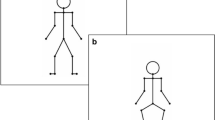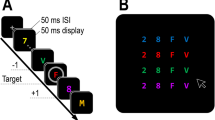Abstract
The clock variance of intervals produced by one finger is reduced when that finger taps along with another finger (termed the bimanual advantage). The multiple-timekeeper model proposes a coupling of internal clocks, leading to reduced clock variance for bimanual timing. Alternatively, reduced variance for bimanual timing could result from additional sensory feedback from two fingers as opposed to one. We aimed to test the role of visual feedback in reducing temporal variability. Participants tapped unimanually and bimanually (with no table contact) in three conditions: full vision, blindfolded, and with additional visual feedback provided via a mirror reflecting the right hand. We predicted that temporal variability would be reduced for tapping with vision versus no vision, and when the left hand was represented by a mirror but did not actually tap. Additional, redundant visual information did not reduce temporal variability for any condition, suggesting that visual feedback is not crucial for bimanual advantage. These findings support the role of sensory feedback (namely, tactile, auditory, and proprioceptive) in reducing timekeeper variability during bimanual timing and argue against a strictly multiple-timekeeper model.



Similar content being viewed by others
References
Chen, Y., Repp, B. H., & Patel, A. D. (2002). Spectral decomposition of variability in synchronization and continuation tapping: Comparisons between auditory and visual pacing and feedback conditions. Human Movement Science, 21, 515–532.
Collins, D. F., Refshauge, K. M., Todd, G., & Gandevia, S. C. (2005). Cutaneous receptors contribute to kinesthesia at the index finger, elbow, and knee. Journal of Neurophysiology, 94, 1699–1706.
Drewing, K., & Aschersleben, G. (2003). Reduced timing variability during bimanual coupling: A role for sensory information. The Quarterly Journal of Experimental Psychology: Section A, 56, 329–350.
Drewing, K., Hennings, M., & Aschersleben, G. (2002). The contribution of tactile reafference to temporal regularity during bimanual finger tapping. Psychological Research, 66, 60–70.
Drewing, K., Stenneken, P., Cole, J., Prinz, W., & Aschersleben, G. (2004). Timing of bimanual movements and deafferentation: Implications for the role of sensory movement effects. Experimental Brain Research, 158, 50–57.
Elliott, M. T., Welchman, A. E., & Wing, A. M. (2009). Being discrete helps keep to the beat. Experimental Brain Research, 192, 731–737.
Hartmann, E., Lachenmayr, B., & Brettel, H. (1979). The peripheral critical flicker frequency. Vision Research, 19, 1019–1023.
Helmuth, L. L., & Ivry, R. B. (1996). When two hands are better than one: Reduced timing variability during bimanual movements. Journal of Experimental Psychology: Human Perception and Performance, 22, 278.
Hove, M. J., & Keller, P. E. (2010). Spatiotemporal relations and movement trajectories in visuomotor synchronization. Music Perception: An Interdisciplinary Journal, 28, 15–26.
Hove, M. J., Spivey, M. J., & Krumhansl, C. L. (2010). Compatibility of motion facilitates visuomotor synchronization. Journal of Experimental Psychology: Human Perception and Performance, 36, 1525–1534.
Ivry, R. B., & Keele, S. W. (1989). Timing functions of the cerebellum. Journal of Cognitive Neuroscience, 1, 136–152.
Ivry, R. B., Keele, S. W., & Diener, H. C. (1988). Dissociation of the lateral and medial cerebellum in movement timing and movement execution. Experimental Brain Research, 73, 167–180.
Ivry, R. B., & Richardson, T. C. (2002). Temporal control and coordination: The multiple timer model. Brain and Cognition, 48, 117–132.
Keele, S. W., & Ivry, R. I. (1988). Modular analysis of timing in motor skill. Psychology of Learning and Motivation, 21, 183–228.
Keele, S. W., Pokorny, R. A., Corcos, D. M., & Ivry, R. (1985). Do perception and motor production share common timing mechanisms: A correlational analysis. Acta Psychologica, 60, 173–191.
Kolers, P. A., & Brewster, J. M. (1985). Rhythms and responses. Journal of Experimental Psychology: Human Perception and Performance, 11, 150.
Mckee, S. P., & Nakayama, K. (1984). The detection of motion in the peripheral visual field. Vision Research, 24, 25–32.
Proske, U., Schaible, H.-G., & Schmidt, R. F. (1988). Joint receptors and kinaesthesia. Experimental Brain Research, 72, 219–224.
Repp, B. H., & Penel, A. (2002). Auditory dominance in temporal processing: New evidence from synchronization with simultaneous visual and auditory sequences. Journal of Experimental Psychology: Human Perception and Performance, 28, 1085.
Repp, B. H., & Penel, A. (2004). Rhythmic movement is attracted more strongly to auditory than to visual rhythms. Psychological Research, 68, 252–270.
Robertson, S. D., Zelaznik, H. N., Lantero, D. A., Bojczyk, K. G., Spencer, R. M., Doffin, J. G., & Schneidt, T. (1999). Correlations for timing consistency among tapping and drawing tasks: Evidence against a single timing process for motor control. Journal of Experimental Psychology: Human Perception and Performance, 25, 1316.
Studenka, B. E., Eliasz, K. L., Shore, D. I., & Balasubramaniam, R. (2014). Crossing the arms confuses the clocks: Sensory feedback and the bimanual advantage. Psychonomic Bulletin & Review, 21, 390–397.
Studenka, B. E., & Zelaznik, H. N. (2011). Synchronization in repetitive smooth movement requires perceptible events. Acta Psychologica, 136, 432–441.
Vorberg, D., & Wing, A. (1996). Modeling variability and dependence in timing. Handbook of Perception and Action, 2, 181–262.
Wing, A. M., & Kristofferson, A. B. (1973a). Response delays and the timing of discrete motor responses. Attention, Perception, & Psychophysics, 14, 5–12.
Wing, A. M., & Kristofferson, A. B. (1973b). The timing of interresponse intervals. Attention, Perception, & Psychophysics, 13, 455–460.
Zelaznik, H. N., & Lantero, D. (1996). The role of vision in repetitive circle drawing. Acta Psychologica, 92, 105–118.
Zelaznik, H. N., & Rosenbaum, D. A. (2010). Timing processes are correlated when tasks share a salient event. Journal of Experimental Psychology: Human Perception and Performance, 36, 1565–1575.
Zelaznik, H. N., Spencer, R., & Ivry, R. B. (2002). Dissociation of explicit and implicit timing in repetitive tapping and drawing movements. Journal of Experimental Psychology: Human Perception and Performance, 28, 575.
Zelaznik, H. N., Vaughn, A. J., Green, J. T., Smith, A. L., Hoza, B., & Linnea, K. (2012). Motor timing deficits in children with attention-deficit/hyperactivity disorder. Human Movement Science, 31, 255–265.
Funding
This study was not funded by any external source.
Author information
Authors and Affiliations
Corresponding author
Ethics declarations
Conflict of interest
Author Studenka declares that she has no conflict of interest. Author Cummins declares that she has no conflict of interest. Author Myers declares that she has no conflict of interest.
Ethical approval
This article does not contain any studies with animals performed by any of the authors. All procedures performed in studies involving human participants were in accordance with the ethical standards of the institutional and/or national research committee and with the 1964 Helsinki declaration and its later amendments or comparable ethical standards.
Informed consent
Informed consent was obtained from all individual participants included in the study.
Additional information
Publisher's Note
Springer Nature remains neutral with regard to jurisdictional claims in published maps and institutional affiliations.
Rights and permissions
About this article
Cite this article
Studenka, B.E., Cummins, D.L. & Myers, K. Visual feedback is not important for bimanual human interval timing. Psychological Research 85, 857–864 (2021). https://doi.org/10.1007/s00426-020-01287-3
Received:
Accepted:
Published:
Issue Date:
DOI: https://doi.org/10.1007/s00426-020-01287-3




